Rebranding? Here’s how social monitoring tools can help

Article summary
In this article, you’ll discover why companies choose to rebrand, how to do it effectively, and why social media listening tools could be the secret ingredient you’re missing. So, if rebranding is on your to-do list, keep reading.
16 minutes read
- What is rebranding?
- Top 7 reasons companies choose to rebrand
- No.1 New markets
- No 2. New mission or philosophy
- No.3 Mergers or acquisitions
- No.4 New locations
- No. 5 When you resemble your competitors
- No. 6 PR crisis
- No. 7 Internal changes
- Top tips on how to prepare to rebrand and win
- Take a look at your audience
- Find out what your audience thinks about your company
- Perform comparative analysis
- Take a look at your content
- Analyze sentiment
- Analyze your data and make a rebranding plan
- Launch a rebrand
- Next steps in rebranding success
For any business, there may come a time when you need a rebrand. And this isn’t always about a crisis. Big names such as Coca-Cola, McDonald's, and Google have successfully undergone rebranding—some more than once.
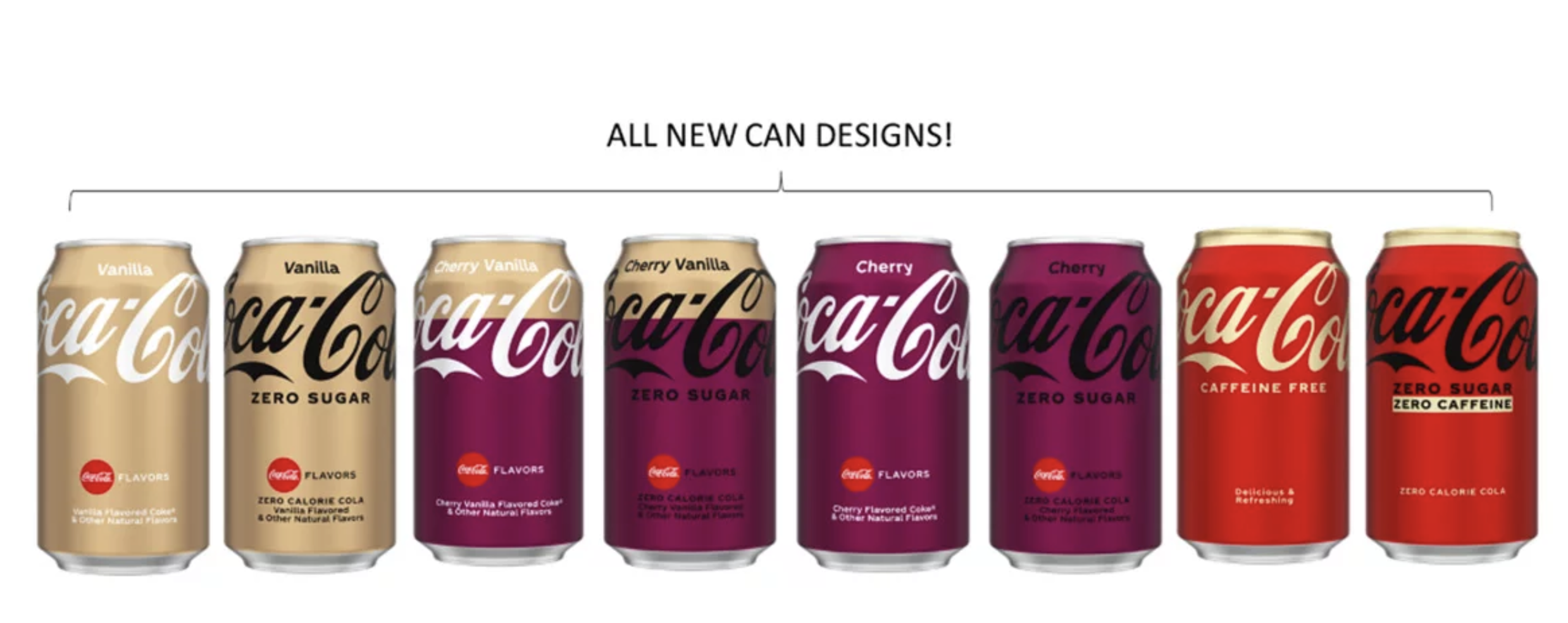
However, rebranding is a challenge. It takes time, effort, preparation, data, and a little pinch of creativity to make it a success. That’s why before changing your brand image it’s essential to dive deep into the tastes and preferences of existing and potential customers, perform well-grounded competitor analysis and investigate the market with the help of social media listening tools.
What is rebranding?
Rebranding is a marketing strategy when a company alters its brand and how it positions itself in the market to redefine its brand image and ideally build a deeper connection with its target audience.
Rebranding activities can vary in scale. Companies can do something simple such as recasting their brand logo, style, or vision as well as undergo some more transformative changes.
Fundamental rebranding can involve remodeling product concepts, reestablishing business values and mission, swapping markets and target audiences, or even changing a product or a brand name.
By signing up I agree to the Terms of Use and Privacy Policy
Top 7 reasons companies choose to rebrand
There are many reasons why companies decide to rebrand. Some newly-minted businesses may fail to come in full force and grab the attention of their customers. Then, they quickly alter their brands' image to patch up the first impression they made.
Meanwhile, others strive to refresh their brand, creating newsworthy events and even driving their social media presence.
No matter why it’s done, when companies get it right, customers take notice. Let’s take a look at some of the top reasons why companies choose to rebrand.
No.1 New markets
Entering new markets means that your business is taking up a new challenge. You have to be ready to adapt to new competition and conditions, bring your product and services up to the competitors’ level and even exceed them, drive to meet constantly growing customer demands, and more.
Under these conditions, rebranding is a necessary step. It will help you ensure the expanding customer base that you can effectively cater to their wants and needs and show your competitors that you’re a serious player in the industry.
No 2. New mission or philosophy
Your audience is changing and so does the market, and your brand also should. To effectively adapt to your customers' tastes, you should follow industry trends 24/7 and adjust your company’s mission and philosophy to them.
A striking example of a massive value shift in companies happened during the Covid pandemics. Lots of businesses realized that they have to focus on their buyers’ individual needs more during the lockdown and prioritize communication with customers to stay afloat.
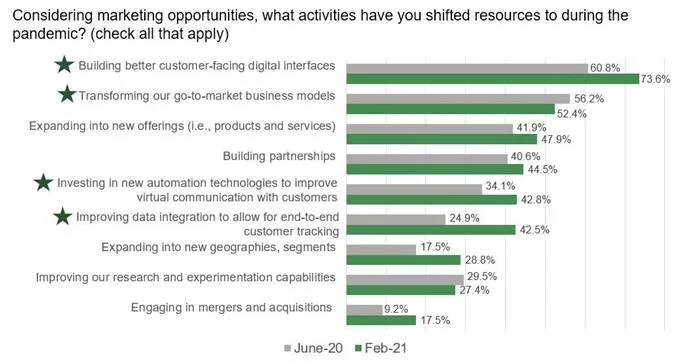
No.3 Mergers or acquisitions
When two businesses decide to join their forces and create a larger company, to retain their customers they need to rebrand. This way, they won’t lose their buyers’ trust, minimize any confusion associated with the event, and will effectively enter new markets.
No.4 New locations
If you feel like the local market is getting smaller and your company is ready to fly higher and go international then it’s the right time to rebrand.
Lots of companies prefer to test the waters and rebrand before entering a barely known market. It’ll help you better connect with new customers, and locations, and avoid any cultural pitfalls. Something that is considered acceptable in your culture can appear strange to others at best. Marketing history has many examples when a brand had to change its logos or names to fit in the local markets.
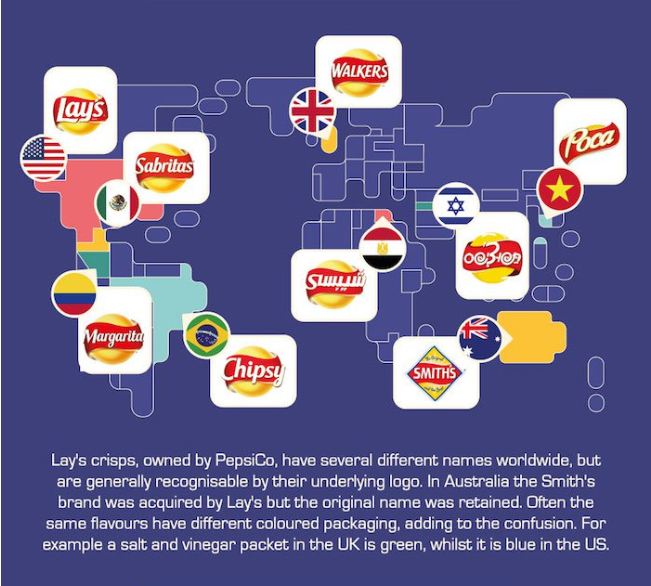
No. 5 When you resemble your competitors
If your brand resembles your competitors, it means that your customers see no difference between the two as well. This increases the risk that even the most committed buyers eventually can turn to your market competitor.
Rebranding is a viable way to stand out. Though before doing one, you need to study your competitors well to avoid running into the same mistake twice.

No. 6 PR crisis
We all have our faults and so do companies and brands. Sometimes a company may get caught up in a scandal due to ill-conceived marketing campaigns or poor product quality, data leaks, or something else. This negative impact can ruin the company’s brand reputation. In such a crisis, rebranding can be a real heaven-sent opportunity that can help make a reset and gain customers’ trust again. Providing it is done authentically—your customers will see through superficial smoke and mirrors attempts.
No. 7 Internal changes
When a company undergoes serious changes, e.g. management transition, then, most of the time, it involves every company’s department, products, and brand. A newly created brand identity can have a positive effect on its recognition and attract more buyers, even those who were reluctant to buy the company's products before.
By signing up I agree to the Terms of Use and Privacy Policy
Top tips on how to prepare to rebrand and win
Now we know why companies choose to rebrand, but how can you do so effectively so that you continue to connect with your main users and attract new ones too.
While rebranding is a complicated and expensive challenge, lots of companies manage to make it less acute for their businesses by using social media listening tools to hone in on true market sentiment.
These tools allow companies to gather detailed data on what are the latest trends in their market, how their customers feel and think about their and their competitors’ brands, how competitors position themselves in the market and figure out why they do so.
Let’s take a look at some of the steps you can take to set your business on the right path to rebranding.
Take a look at your audience
When planning rebranding activities, one of the first things companies do is formulate their objectives and define the audience they’re going to target their marketing activities.
Social media listening tools such as Awario can help you look at your audience from a new angle. Get informative insights on who your buyers are and what they prefer. For this, check the main dashboard or go to app statistics and learn about your followers’ location, age and gender, the language they speak, which social media sites they prefer to use, and much more.
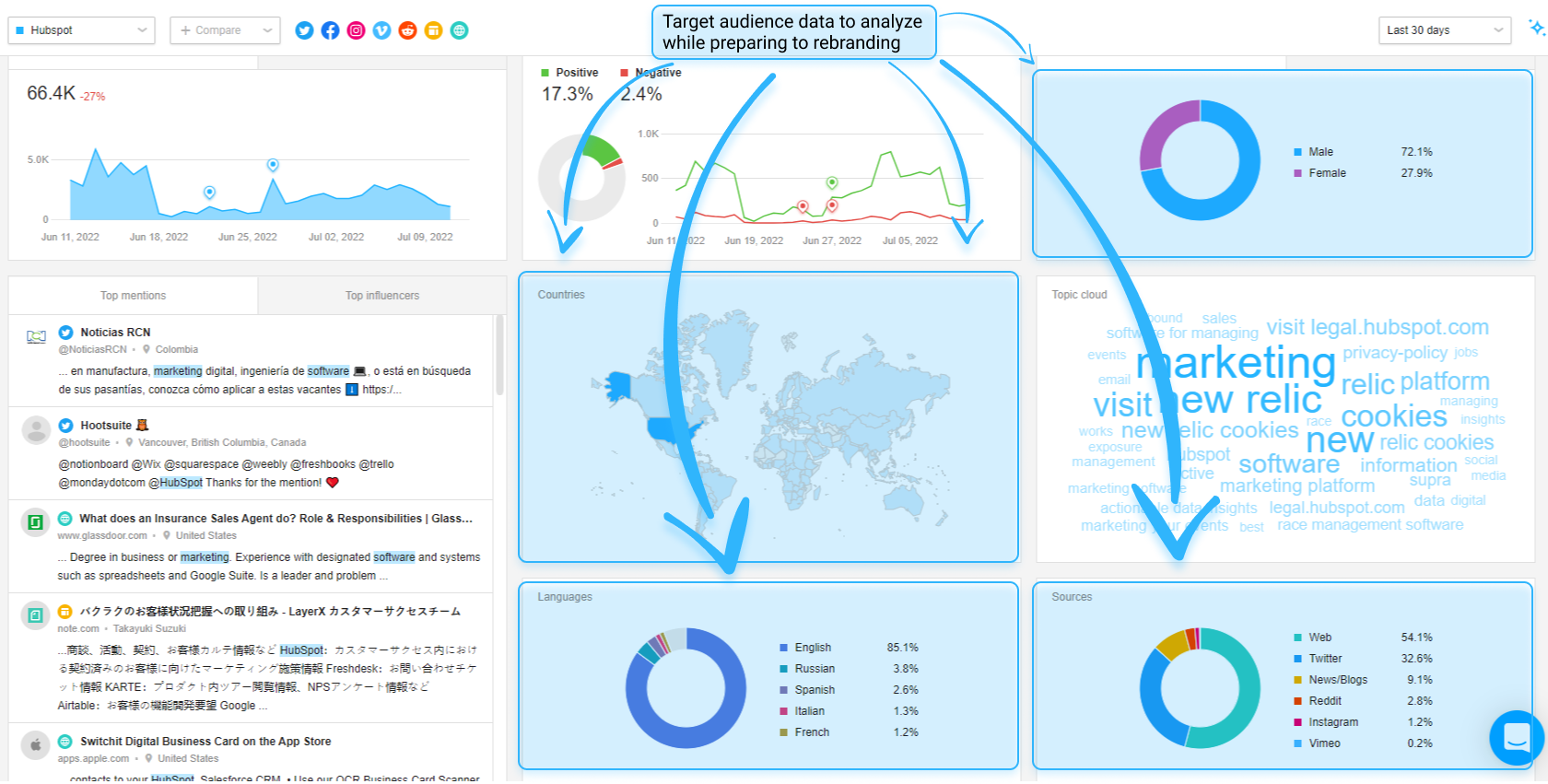
Thoroughly analyzing statistical data will allow you to develop detailed customer personas and make your marketing companies even more successful. This can be especially valuable if you’re aiming at several markets at once. You’ll be able to see the difference between your international customers, better understand the cultural aspects of your audiences, and create marketing campaigns perfectly adjusted to each of them.
Find out what your audience thinks about your company
Another step before immersing in rebranding is to investigate what your key audience and your potential buyers think of your company and your brand.
Lots of social media monitoring tools provide marketers with a topic cloud for that. A topic cloud gathers the main words that are associated with your business. The bigger the word, the more it’s associated with your brand. Study the cloud carefully. You can click on the words to find out what social media posts they come from and how they’re related to you in those messages.
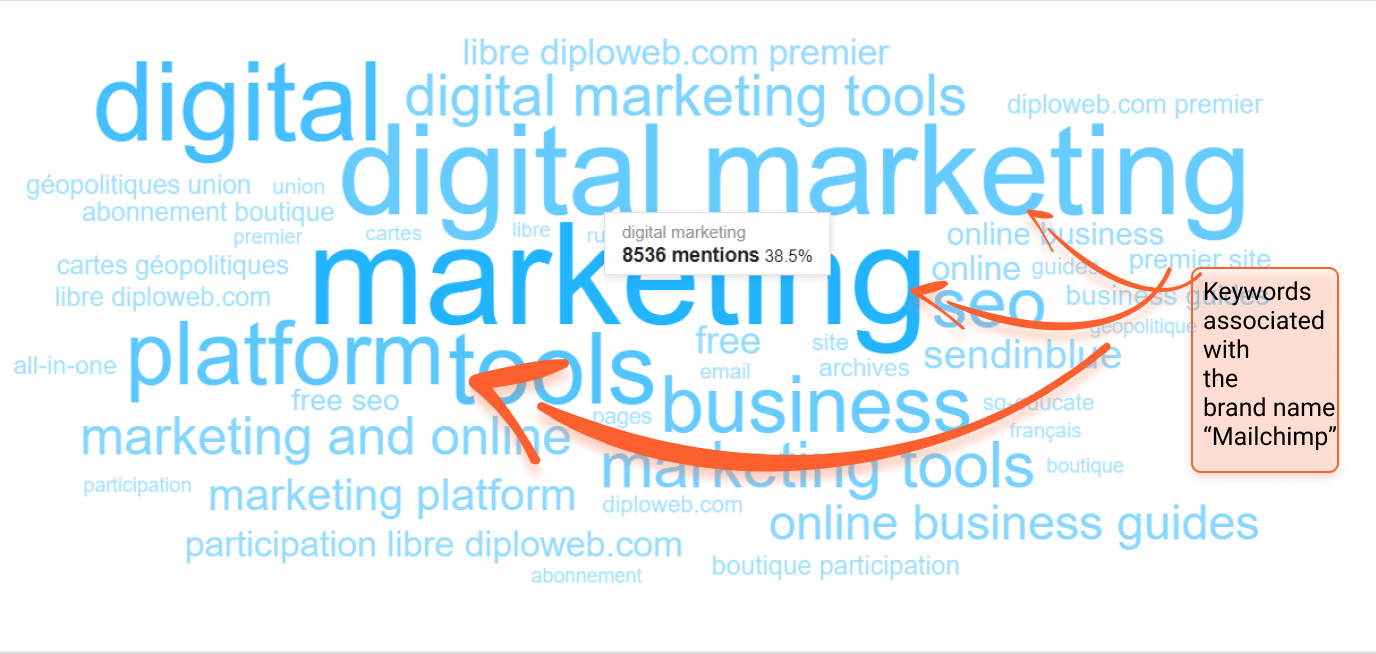
After getting through the word associations, you might already have some ideas for your future marketing strategies. Though, don’t rush with that just yet. Think about how these words could reflect your strengths and weaknesses and what you could do to improve the look of your upgraded brand.
Perform comparative analysis
As you’ve learned a lot about your target audience, it’s time to know more about the competitors. These can be the companies in your local market. Though, if you’re aiming at something more and planning to expand internationally, then carefully study the competitors in your niche.
For this, you should understand what position your business is having in the market now – if you’re a market leader, challenger, follower, or niche and which position you’re aiming for. Then, analyze your competitors and compare the results. It’s much simpler to perform this complex analysis when you use social media listening tools.

With social monitoring tools, you’ll be able to create competitor monitoring projects with comprehensive analysis. That will give you lots of insights into your business and your competitors’ performance. Having this data will allow you to successfully undergo rebranding, effectively address and eradicate your current brand flaws, and better address your potential customer demands.
Take a look at your content
When companies rebrand they often change their content as well–their voice, tone of addressing their customers, keywords they use, and more. Though, to understand how you should improve your content, you’ve got to realize what kind of content you already have.
Monitoring your marketing campaigns and assessing their effectiveness with social media listening tools will help you understand how successfully your brand is floating around social media. For this, have a look at what your audience likes best about your marketing companies, what it tends to share and comment on, and what type of content gets the biggest reach. It’s simple to do in Awario’s project feeds where you can quickly browse through all the recent posts, and sort them out by tags, language, location, social media, and more.
Having understood your content's strong and weak points, it’ll be much easier for you to create new content strategies for your campaigns as you rebrand.
Analyze sentiment
Sentiment shows an overall perception of your brand by your followers and potential customers. You can track your brand sentiment in social media monitoring tools. For example, Awario shows positive and negative sentiment in the messages it finds around the Internet.
The sentiment feature will quickly show netizens’ attitudes towards your brand, its advantages, and drawbacks. You can get to each post with negative and positive sentiments and check who left the message and on what social media platform they did it.

After having undergone rebranding, lots of companies still prefer monitoring their performance online and you can do the same. Following the messages with sentiment allows you to quickly get in contact with your audience, address their concerns or thank them for positive comments. This is especially important in the first month after rebranding when you present your brand achievements to your audience and on the Internet.
Analyze your data and make a rebranding plan
Having gathered and analyzed all the data on your brand’s and your competitors’ performances, your audience preferences, and the prospects offered by the potential markets, it’s safe to say that you’re ready to make your rebranding plan.
Based on the performed analysis, define what rebranding strategies you need to follow. They can include:
-
Changing your logo so that it better matches your brand’s new identity,
-
Alter your brand positioning–this can include a change of colors, the company’s website design, tone of communication, mission, values, and brand vision.
-
Create new content–this can be new types of ads and blog posts on your website, a new voice in messages on social media, and more.
Think how else you could improve your brand to make it more appealing to your followers and customers.
Launch a rebrand
As you’ve got your rebranding plan grounded on a thorough analysis of social media, competitors, and new markets, the moment of truth has come–it’s time to rebrand!
After having implemented all of the changes, just keep monitoring your brand performance online. This way, you’ll be able to get immediate feedback on the rebranding results. Moreover, if something goes wrong, you can quickly fix minor issues or quickly roll back the changes to the default state.
Next steps in rebranding success
Undertaking a rebranding is never an easy task, no matter if your brand is big or small. That’s why, you’ve got to be all set before starting out on this demanding activity. A viable option for successful rebranding is to get equipped with robust analytical tools such as social media listening apps.
Social media monitoring tools will help you understand your current brand’s position on the market, its strengths and weaknesses, the followers’ attitudes, and much more. Moreover, social media listening tools can provide you with valuable insights on how to improve your brand positioning and show the perspectives of new markets. All this knowledge you can include in your rebranding plan and come up with a new and better brand after making all of the changes.













